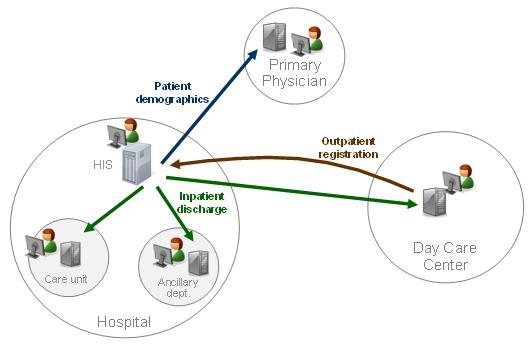Difference between revisions of "Patient Administration Management"
| Line 48: | Line 48: | ||
::* Appendix E: Usage of CX Data Type in PID-3 - Patient Identifier List | ::* Appendix E: Usage of CX Data Type in PID-3 - Patient Identifier List | ||
::* Appendix N: Common HL7 Data Types | ::* Appendix N: Common HL7 Data Types | ||
| + | ::* Appendix P: Examples of messages | ||
'''Underlying Standards:''' | '''Underlying Standards:''' | ||
| − | :* [http://www.hl7.org HL7] | + | :* [http://www.hl7.org HL7 v2.5] |
==See Also== | ==See Also== | ||
Revision as of 09:40, 2 April 2008
Patient Administration Management (PAM) enables applications to share accurate patient demographic data within and between acute care settings as well as between those and ambulatory healthcare providers.
Summary
The PAM profile specifies two transactions to fulfill two great missions among applications dealing with healthcare:
- Patient Identity Feed: Maintain consistency of patient demographics (i.e. patient identitification, full identity and persons related to the patient such as primary caregiver, family doctor, guarantor, next of kin) across applications operating in acute care settings as well as in the ambulatory environment.
- Patient Encounter Management: Coordinate the exchange of patient account, encounter and location information within and between acute care settings.
These two transactions provide sets of event-triggered messages, notifying the creation and update of patient administrative data. Each transaction involves a pair of (Supplier, Consumer) Actors. Transaction Patient Identity Feed operates in a centralized manner (one Supplier application providing a number of Consumers). Transaction Patient Encounter Management can work in centralized mode as well as in peer to peer mode (Several applications cooperating as peers, each one playing alternatively Supplier and Consumer roles).

Benefits
Reduce Errors and Enhance Patient Care
- Prevents manual data entry errors by ensuring that each piece of patient or encounter data is entered only once
Improve Throughput
Details
The Patient Administration Management (PAM) Integration Profile:
Systems Affected
Systems involved in this profile are:
- Enterprise-wide information systems that manage patient registration (i.e., admit-discharge-transfer /registration system and hospital information system (HIS ))
Actors & Transactions:
Specification
Profile Status: Final Text
Documents: IHE IT Infrastructure Technical Framework:
- Vol. 1 - Section 4 (PAM profile overview, use cases, actors, transactions, options, groupings)
- Vol. 2:
- Section 3.30: Transaction Patient Identity Feed
- Section 3.31: Transaction Patient Encounter Management
- Appendix C: HL7 Profiling Conventions
- Appendix E: Usage of CX Data Type in PID-3 - Patient Identifier List
- Appendix N: Common HL7 Data Types
- Appendix P: Examples of messages
Underlying Standards:
See Also
Related Profiles
- Patient Demographics Query [PDQ] ...
Consumer Information
Implementer Information
This page is based on the Profile Template